Historical Foundations of Modern English Spelling List

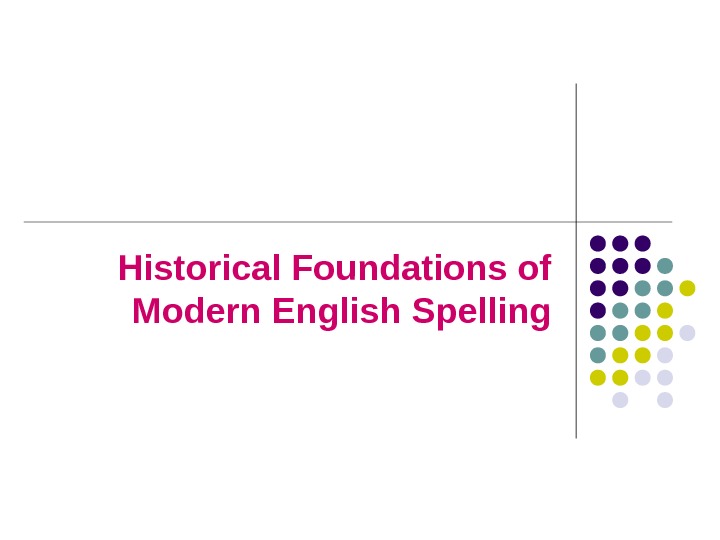
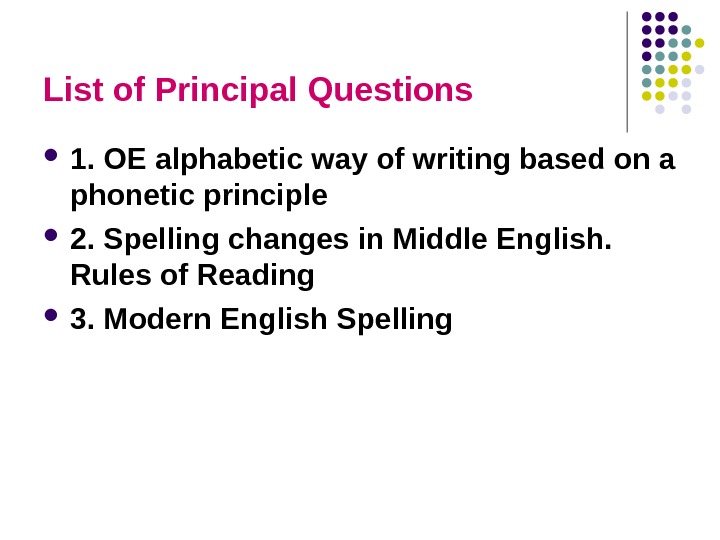


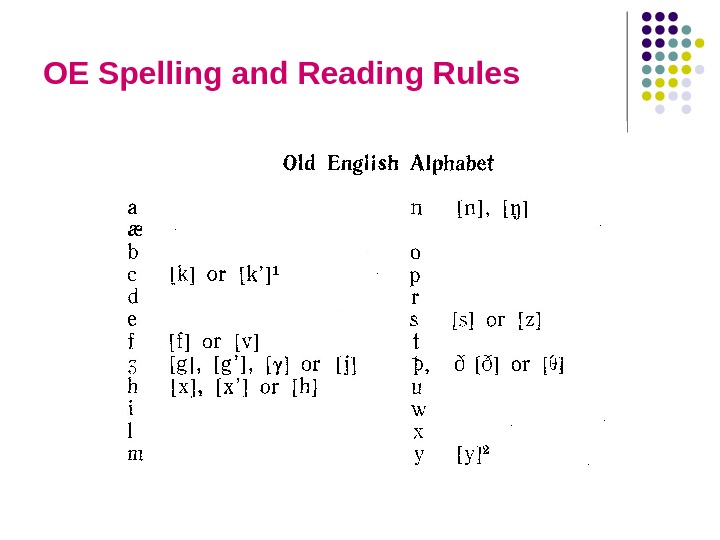

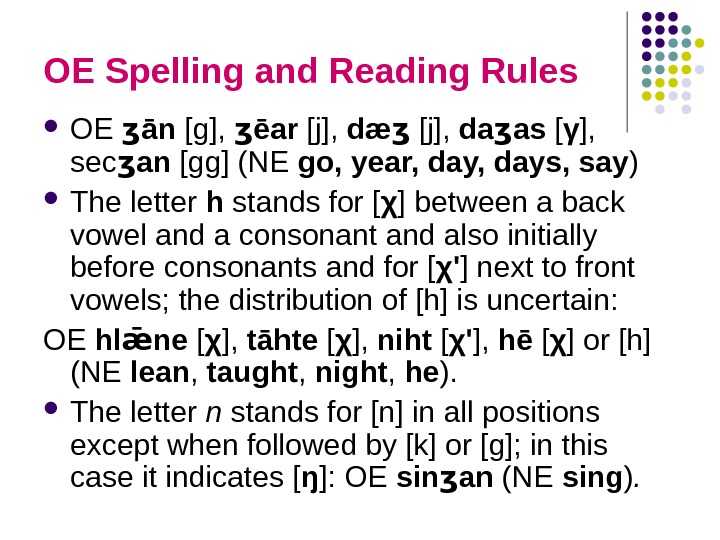

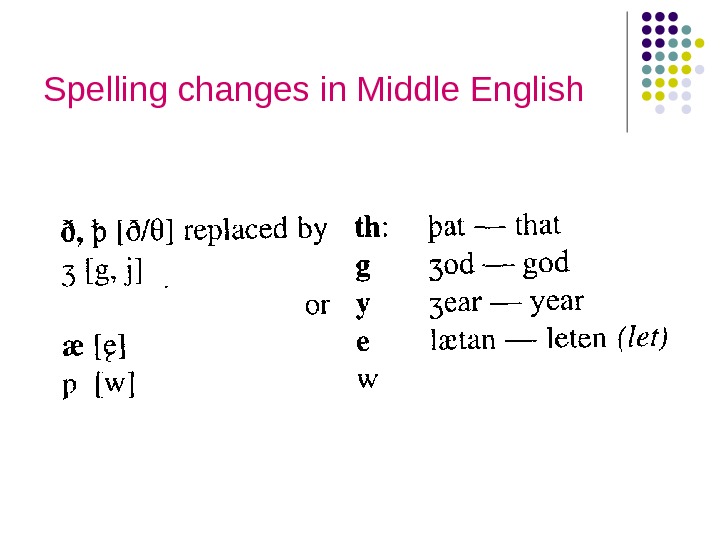
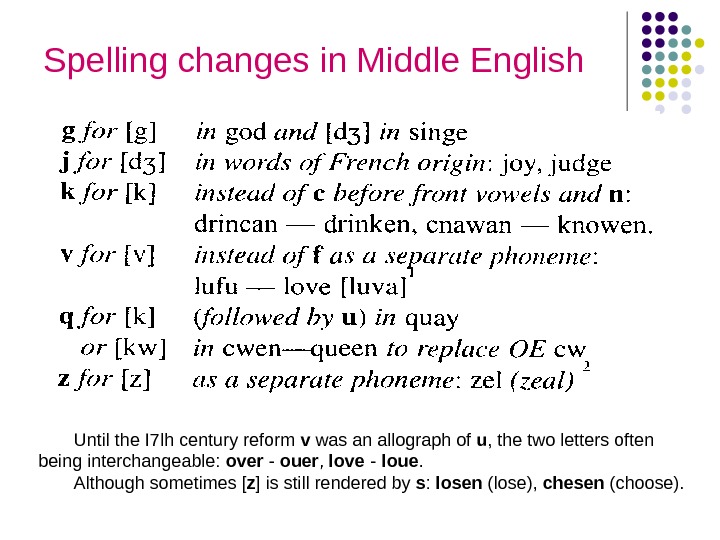
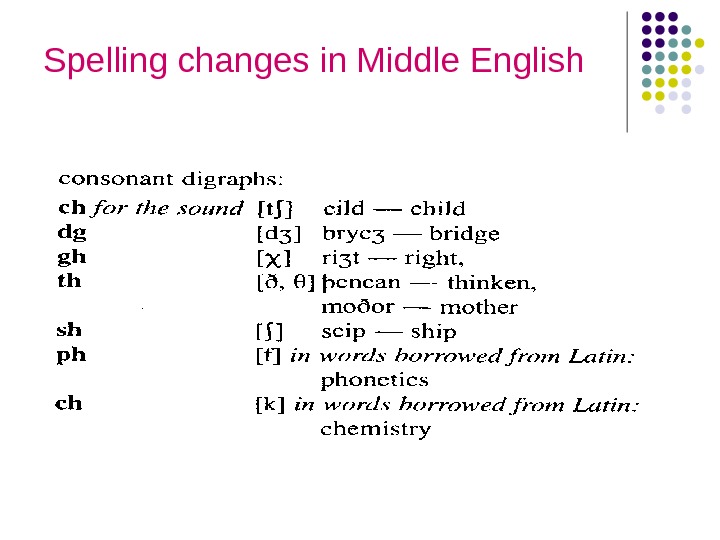

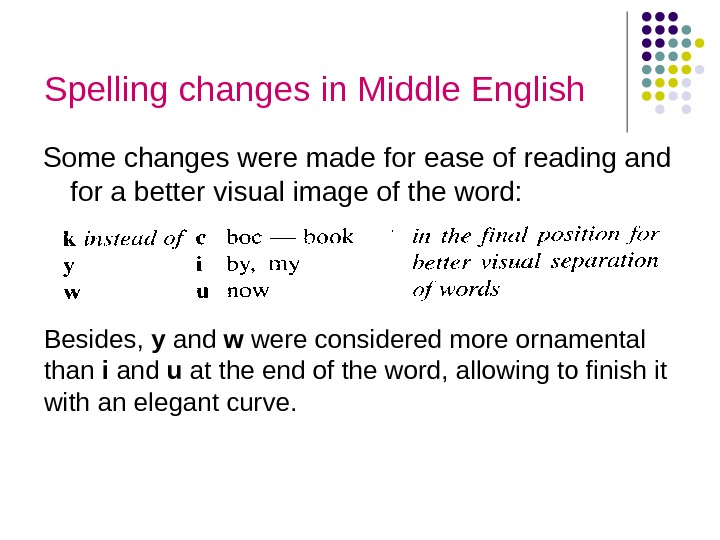
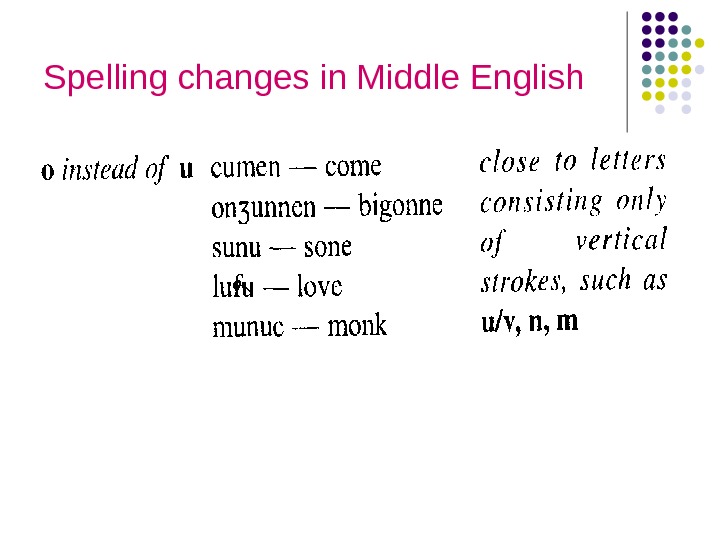
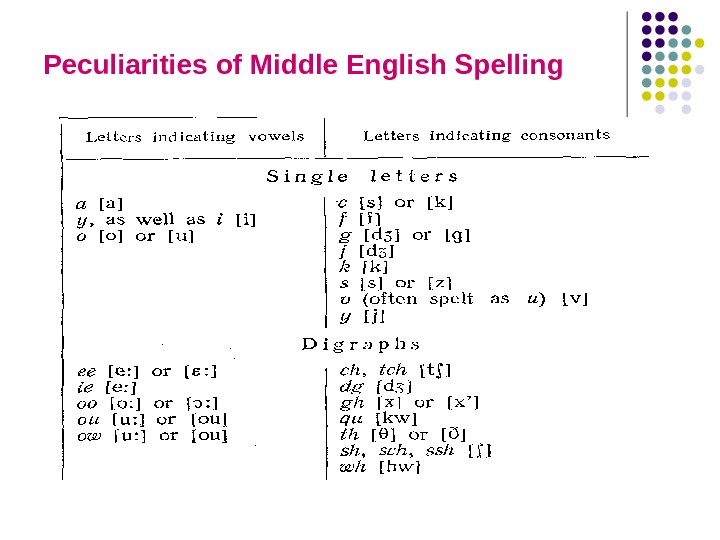
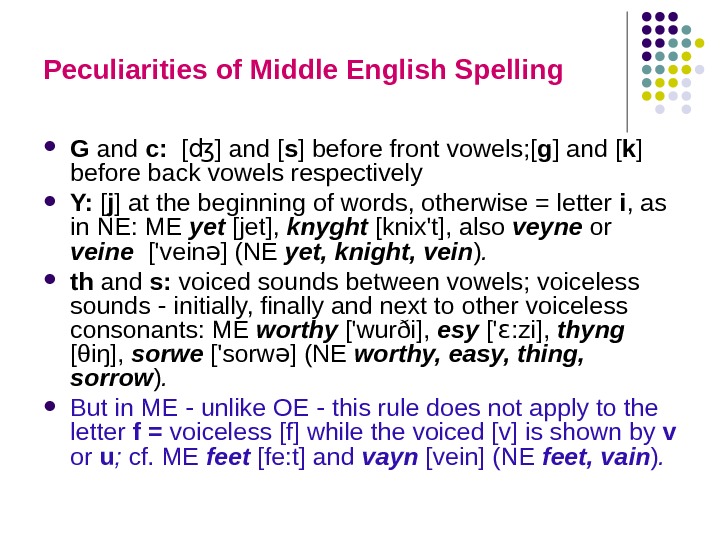

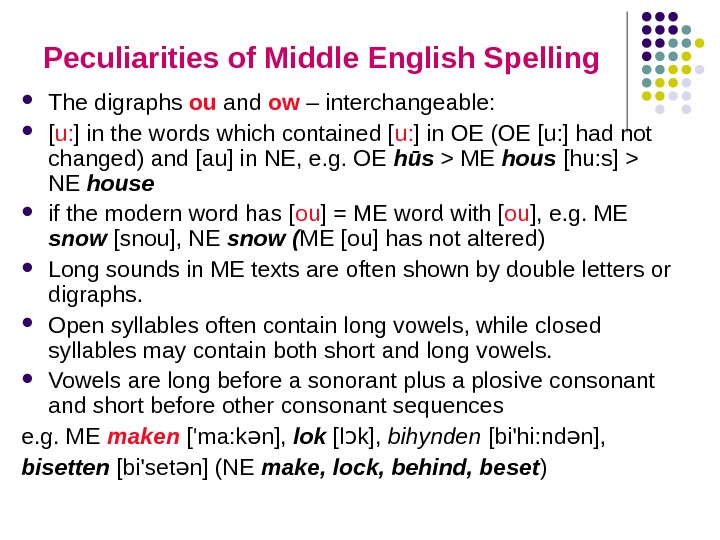



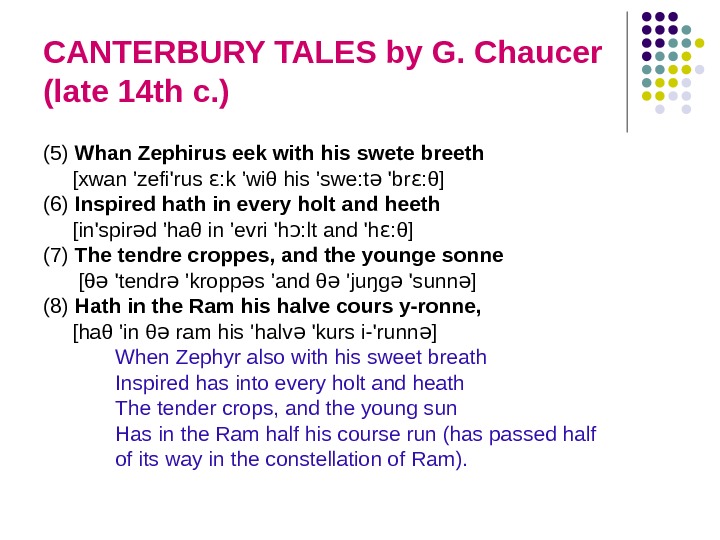
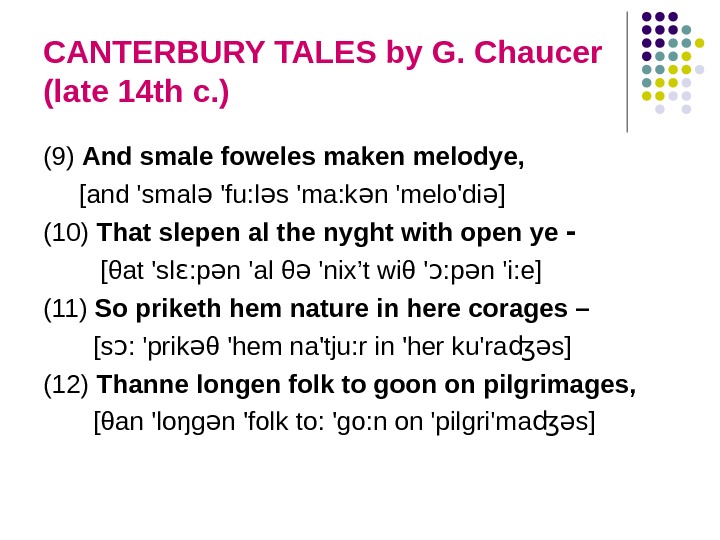
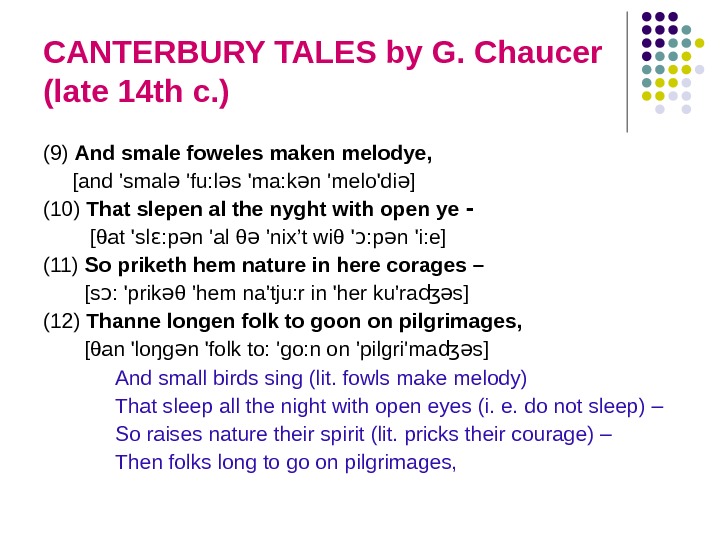



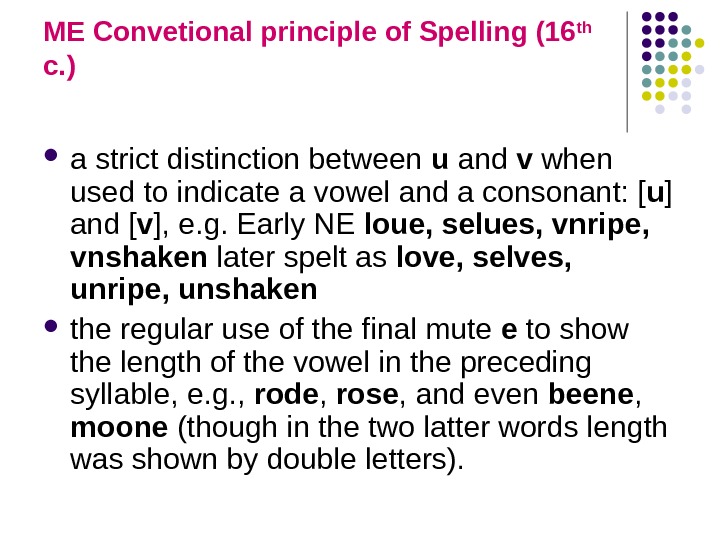
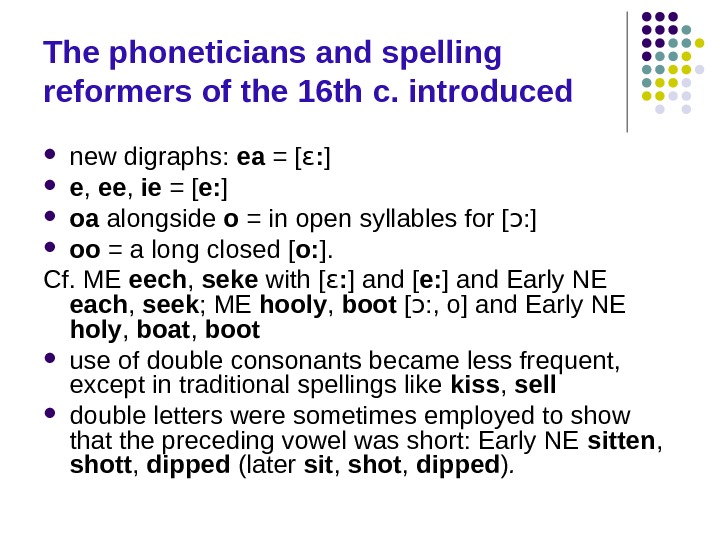

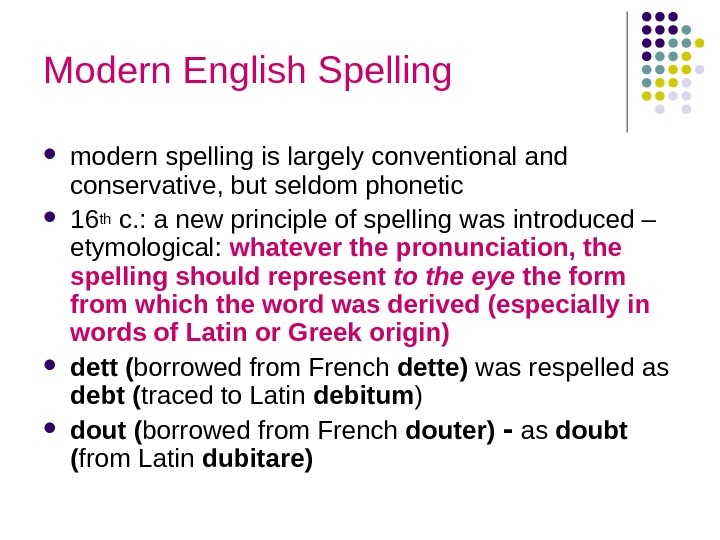
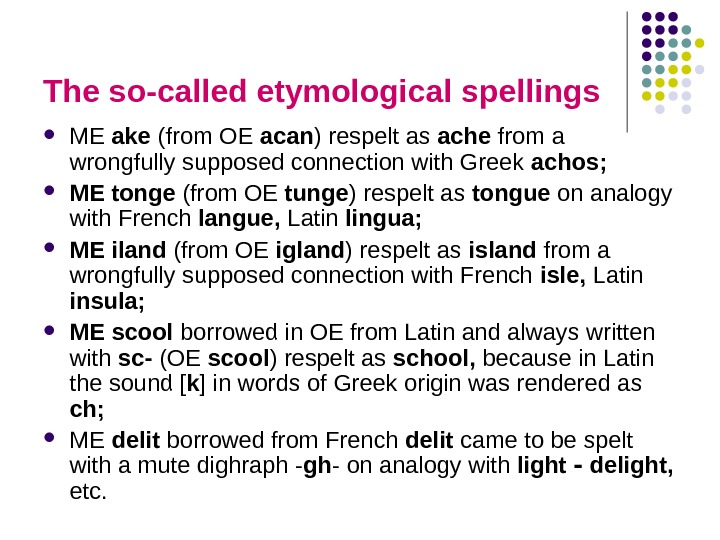
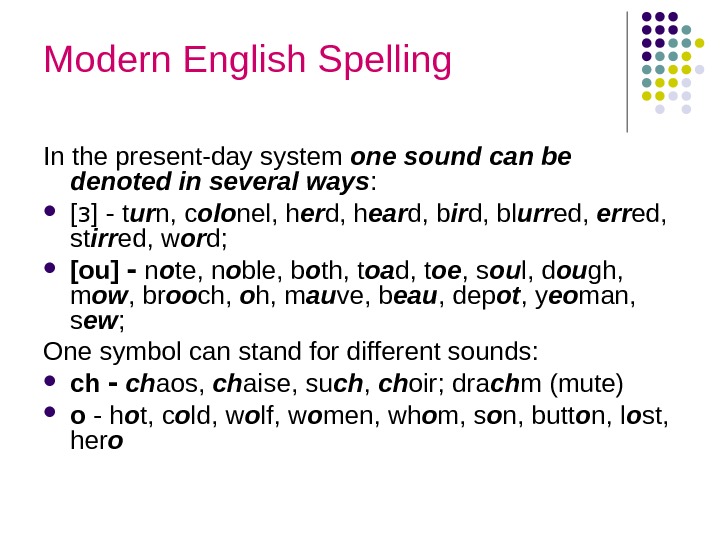
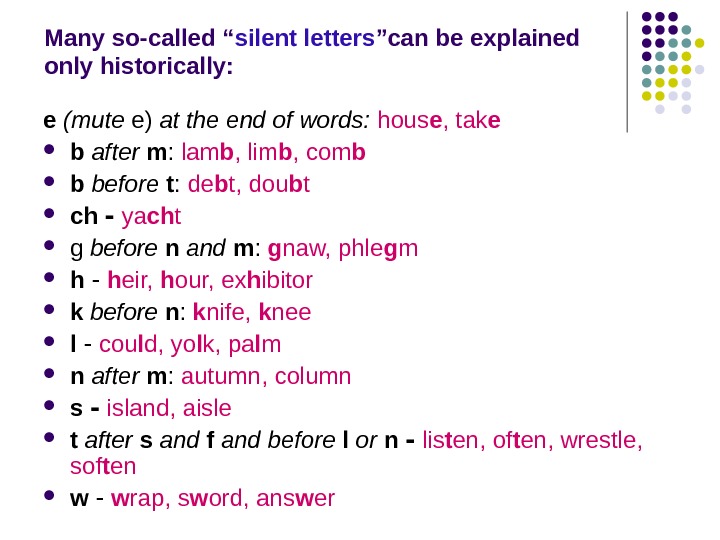
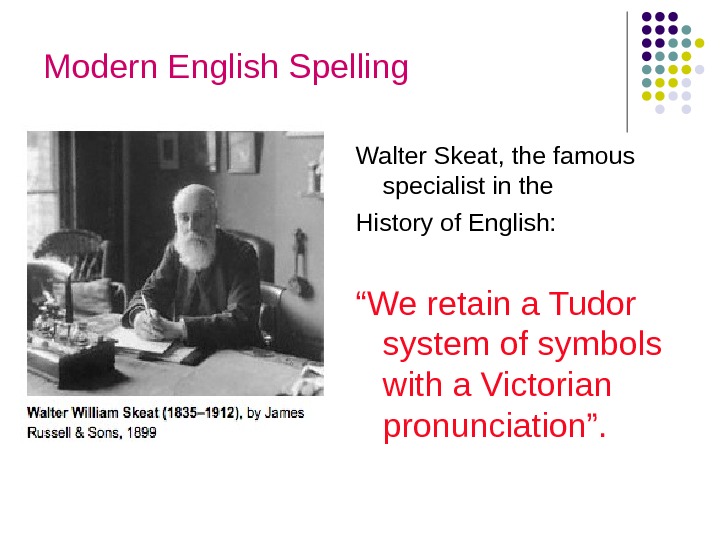
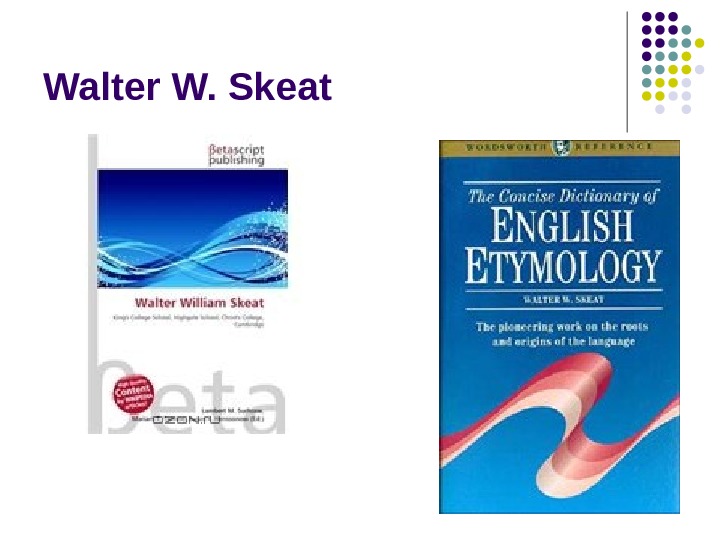
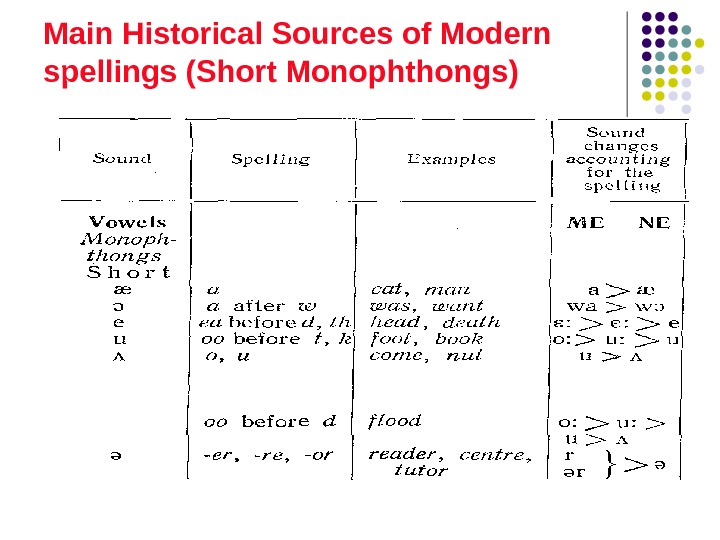
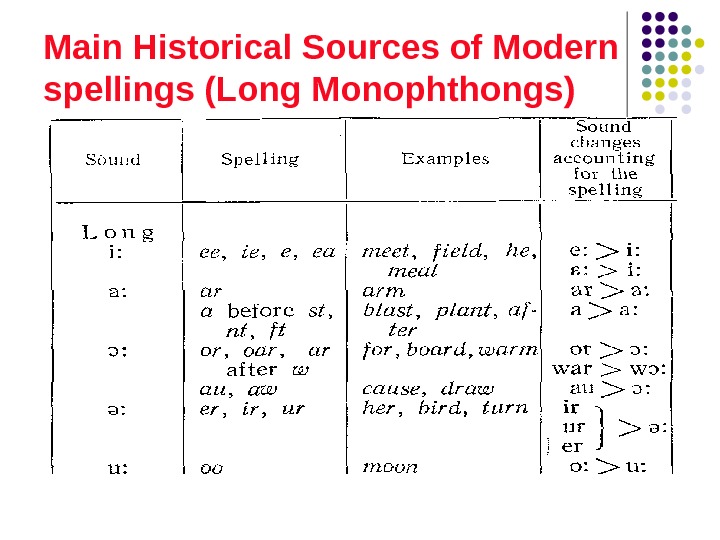
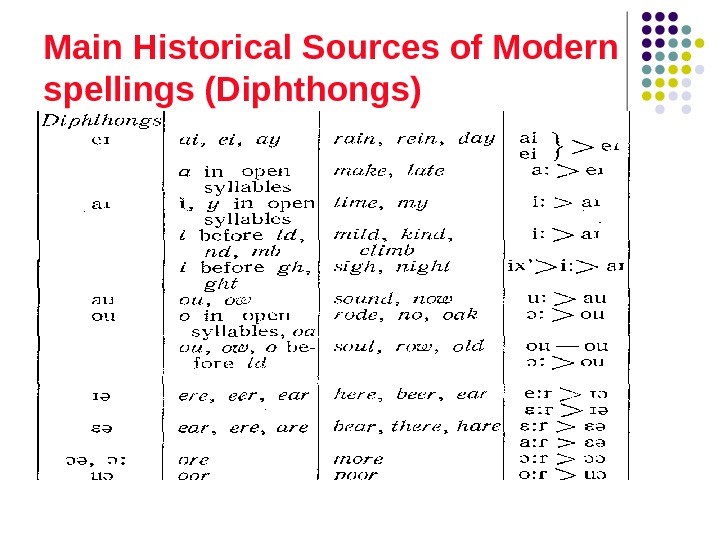

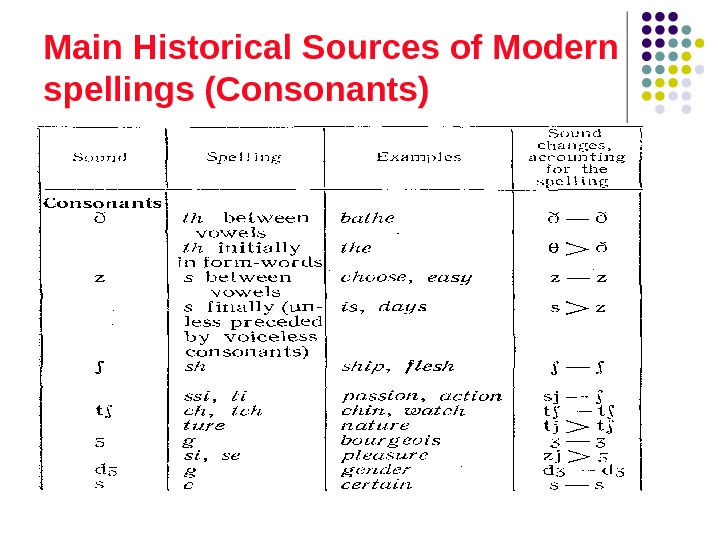
- Размер: 489.5 Кб
- Количество слайдов: 41
Описание презентации Historical Foundations of Modern English Spelling List по слайдам
 Historical Foundations of Modern English Spelling
Historical Foundations of Modern English Spelling
 List of Principal Questions 1. OE alphabetic way of writing based on a phonetic principle 2. Spelling changes in Middle English. Rules of Reading 3. Modern English Spelling
List of Principal Questions 1. OE alphabetic way of writing based on a phonetic principle 2. Spelling changes in Middle English. Rules of Reading 3. Modern English Spelling
 1. OE alphabetic way of writing based on a phonetic principle The Ways of writing: Hieroglyphic Pictographic Syllabic Alphabetic — originally based on a phonetic principle: an accurate graphic representation of pronunciation by using letters to indicate sounds
1. OE alphabetic way of writing based on a phonetic principle The Ways of writing: Hieroglyphic Pictographic Syllabic Alphabetic — originally based on a phonetic principle: an accurate graphic representation of pronunciation by using letters to indicate sounds
 OE spelling a separate letter for each distinct sound the sound values of the letters were for the most part the same as in Latin spellings, however, were not absolutely consistent:
OE spelling a separate letter for each distinct sound the sound values of the letters were for the most part the same as in Latin spellings, however, were not absolutely consistent:
 OE Spelling and Reading Rules
OE Spelling and Reading Rules
 OE Spelling and Reading Rules
OE Spelling and Reading Rules
![OE Spelling and Reading Rules OE ān ʒ [g], ēar ʒ [j], dæ ʒ OE Spelling and Reading Rules OE ān ʒ [g], ēar ʒ [j], dæ ʒ](/docs//presentation_me_11_images/presentation_me_11_6.jpg) OE Spelling and Reading Rules OE ān ʒ [g], ēar ʒ [j], dæ ʒ [j], da as ʒ [ γ ], sec an ʒ [gg] (NE go, year, days, say ) The letter h stands for [ χ ] between a back vowel and a consonant and also initially before consonants and for [ χ’ ] next to front vowels; the distribution of [h] is uncertain: OE hl ne ǣ [ χ ], tāhte [ χ ], niht [ χ’ ], hē [ χ ] or [h] (NE lean , taught , night , he ). The letter n stands for [n] in all positions except when followed by [k] or [g]; in this case it indicates [ ŋ ]: OE sin an ʒ (NE sing ).
OE Spelling and Reading Rules OE ān ʒ [g], ēar ʒ [j], dæ ʒ [j], da as ʒ [ γ ], sec an ʒ [gg] (NE go, year, days, say ) The letter h stands for [ χ ] between a back vowel and a consonant and also initially before consonants and for [ χ’ ] next to front vowels; the distribution of [h] is uncertain: OE hl ne ǣ [ χ ], tāhte [ χ ], niht [ χ’ ], hē [ χ ] or [h] (NE lean , taught , night , he ). The letter n stands for [n] in all positions except when followed by [k] or [g]; in this case it indicates [ ŋ ]: OE sin an ʒ (NE sing ).
 2. Spelling changes in Middle English. Rules of Reading In Middle English the former Anglo-Saxon spelling tradition was replaced by that of the Norman scribes reflecting the influence of French and often mixing purely phonetic spelling with French spelling habits and traditions inherited from Old English.
2. Spelling changes in Middle English. Rules of Reading In Middle English the former Anglo-Saxon spelling tradition was replaced by that of the Norman scribes reflecting the influence of French and often mixing purely phonetic spelling with French spelling habits and traditions inherited from Old English.
 Spelling changes in Middle English
Spelling changes in Middle English
 Spelling changes in Middle English Until the I 7 lh century reform v was an allograph of u , the two letters often being interchangeable: over ‑ ouer , love ‑ loue. Although sometimes [ z ] is still rendered by s : losen (lose), chesen (choose).
Spelling changes in Middle English Until the I 7 lh century reform v was an allograph of u , the two letters often being interchangeable: over ‑ ouer , love ‑ loue. Although sometimes [ z ] is still rendered by s : losen (lose), chesen (choose).
 Spelling changes in Middle English
Spelling changes in Middle English
 Spelling changes in Middle English
Spelling changes in Middle English
 Spelling changes in Middle English Some changes were made for ease of reading and for a better visual image of the word: Besides, у and w were considered more ornamental than i and u at the end of the word, allowing to finish it with an elegant curve.
Spelling changes in Middle English Some changes were made for ease of reading and for a better visual image of the word: Besides, у and w were considered more ornamental than i and u at the end of the word, allowing to finish it with an elegant curve.
 Spelling changes in Middle English
Spelling changes in Middle English
 Peculiarities of Middle English Spelling
Peculiarities of Middle English Spelling
![Peculiarities of Middle English Spelling G and с : [ ] and [ʤ s ] Peculiarities of Middle English Spelling G and с : [ ] and [ʤ s ]](/docs//presentation_me_11_images/presentation_me_11_15.jpg) Peculiarities of Middle English Spelling G and с : [ ] and [ʤ s ] before front vowels; [ g ] and [ k ] before back vowels respectively Y: [ j ] at the beginning of words, otherwise = letter i , as in NE: ME yet [jet], knyght [knix’t], also veyne or veine [‘vein ] (NE ə yet, knight, vein ). th and s: voiced sounds between vowels; voiceless sounds initially, finally and next to other voiceless ‑ consonants: ME worthy [‘wurði], esy [‘ : zi], ɛ thyng [θiŋ], sorwe [‘sorw ] (NE ə worthy, easy, thing, sorrow ). But in ME unlike OE this rule does not apply to the ‑ ‑ letter f = voiceless [f] while the voiced [v] is shown by v or u ; cf. ME feet [fe: t] and vayn [vein] (NE feet, vain ).
Peculiarities of Middle English Spelling G and с : [ ] and [ʤ s ] before front vowels; [ g ] and [ k ] before back vowels respectively Y: [ j ] at the beginning of words, otherwise = letter i , as in NE: ME yet [jet], knyght [knix’t], also veyne or veine [‘vein ] (NE ə yet, knight, vein ). th and s: voiced sounds between vowels; voiceless sounds initially, finally and next to other voiceless ‑ consonants: ME worthy [‘wurði], esy [‘ : zi], ɛ thyng [θiŋ], sorwe [‘sorw ] (NE ə worthy, easy, thing, sorrow ). But in ME unlike OE this rule does not apply to the ‑ ‑ letter f = voiceless [f] while the voiced [v] is shown by v or u ; cf. ME feet [fe: t] and vayn [vein] (NE feet, vain ).
![Peculiarities of Middle English Spelling O = usually [u] next to letters whose shape resembles the Peculiarities of Middle English Spelling O = usually [u] next to letters whose shape resembles the](/docs//presentation_me_11_images/presentation_me_11_16.jpg) Peculiarities of Middle English Spelling O = usually [u] next to letters whose shape resembles the shape of the letter u ( ME some [‘sum ])ə but in the same environment it can indicate [o] ( то n е [‘mo: n ] ə To determine the sound value of о one can look up the origin of the sound in OE or the pronunciation of the word in NE: the sound [ u ] did not change in the transition from OE to ME (the OE for some was sum ); in NE it changed to [ ٨ ]. the letter о stood for [ u ] in those ME words which contain [ ٨ ] today, otherwise it indicates [ o ]. Cf. , e. g. ME some [‘sum ], ə not [n t] (NE ɔ some, not ).
Peculiarities of Middle English Spelling O = usually [u] next to letters whose shape resembles the shape of the letter u ( ME some [‘sum ])ə but in the same environment it can indicate [o] ( то n е [‘mo: n ] ə To determine the sound value of о one can look up the origin of the sound in OE or the pronunciation of the word in NE: the sound [ u ] did not change in the transition from OE to ME (the OE for some was sum ); in NE it changed to [ ٨ ]. the letter о stood for [ u ] in those ME words which contain [ ٨ ] today, otherwise it indicates [ o ]. Cf. , e. g. ME some [‘sum ], ə not [n t] (NE ɔ some, not ).
 Peculiarities of Middle English Spelling The digraphs ou and ow – interchangeable: [ u: ] in the words which contained [ u: ] in OE (OE [u: ] had not changed) and [au] in NE, e. g. OE hūs > ME hous [hu: s] > NE house if the modern word has [ ou ] = ME word with [ ou ], e. g. ME snow [snou], NE snow ( ME [ou] has not altered) Long sounds in ME texts are often shown by double letters or digraphs. Open syllables often contain long vowels, while closed syllables may contain both short and long vowels. Vowels are long before a sonorant plus a plosive consonant and short before other consonant sequences e. g. ME maken [‘ma: k n], ə lok [l k], ɔ bihynden [bi’hi: nd n], ə bisetten [bi’set n] (NE ə make, lock, behind, beset )
Peculiarities of Middle English Spelling The digraphs ou and ow – interchangeable: [ u: ] in the words which contained [ u: ] in OE (OE [u: ] had not changed) and [au] in NE, e. g. OE hūs > ME hous [hu: s] > NE house if the modern word has [ ou ] = ME word with [ ou ], e. g. ME snow [snou], NE snow ( ME [ou] has not altered) Long sounds in ME texts are often shown by double letters or digraphs. Open syllables often contain long vowels, while closed syllables may contain both short and long vowels. Vowels are long before a sonorant plus a plosive consonant and short before other consonant sequences e. g. ME maken [‘ma: k n], ə lok [l k], ɔ bihynden [bi’hi: nd n], ə bisetten [bi’set n] (NE ə make, lock, behind, beset )
 CANTERBURY TALES by G. Chaucer (late 14 th c. ) (1) Whan that Aprille with his shoures soote [xwan ‘θat ap’ril ‘wiθ his ‘ u: r s ‘so: t ]ə ʃ ə ə (2) the droghte of March hath perced to the roote, [θ ‘druxt of ‘mar haθ ‘pers d ‘to: θ ‘ro: t ] ə ʧ ə ə ə (3) And bathed every veyne in swich licour, [and ‘ba: ð d ‘evri ‘vein in ‘swi li’ku: r] ə ʧ (4) Of which vertu engendred is the flour; [of ‘xwi ver’tju: en’ endr d ‘is θ ‘flu: r] ʧ ʤ ə ə
CANTERBURY TALES by G. Chaucer (late 14 th c. ) (1) Whan that Aprille with his shoures soote [xwan ‘θat ap’ril ‘wiθ his ‘ u: r s ‘so: t ]ə ʃ ə ə (2) the droghte of March hath perced to the roote, [θ ‘druxt of ‘mar haθ ‘pers d ‘to: θ ‘ro: t ] ə ʧ ə ə ə (3) And bathed every veyne in swich licour, [and ‘ba: ð d ‘evri ‘vein in ‘swi li’ku: r] ə ʧ (4) Of which vertu engendred is the flour; [of ‘xwi ver’tju: en’ endr d ‘is θ ‘flu: r] ʧ ʤ ə ə
 CANTERBURY TALES by G. Chaucer (late 14 th c. ) (1) Whan that Aprille with his shoures soote [xwan ‘θat ap’ril ‘wiθ his ‘ u: r s ‘so: t ]ə ʃ ə ə (2) the droghte of March hath perced to the roote, [θ ‘druxt of ‘mar haθ ‘pers d ‘to: θ ‘ro: t ] ə ʧ ə ə ə (3) And bathed every veyne in swich licour, [and ‘ba: ð d ‘evri ‘vein in ‘swi li’ku: r] ə ʧ (4) Of which vertu engendred is the flour; [of ‘xwi ver’tju: en’ endr d ‘is θ ‘flu: r] ʧ ʤ ə ə When April with his sweet showers The draught of March has pierced to the root, And bathed every vein in such liquor, Of which (whose) virtue (power) engendered is the flower;
CANTERBURY TALES by G. Chaucer (late 14 th c. ) (1) Whan that Aprille with his shoures soote [xwan ‘θat ap’ril ‘wiθ his ‘ u: r s ‘so: t ]ə ʃ ə ə (2) the droghte of March hath perced to the roote, [θ ‘druxt of ‘mar haθ ‘pers d ‘to: θ ‘ro: t ] ə ʧ ə ə ə (3) And bathed every veyne in swich licour, [and ‘ba: ð d ‘evri ‘vein in ‘swi li’ku: r] ə ʧ (4) Of which vertu engendred is the flour; [of ‘xwi ver’tju: en’ endr d ‘is θ ‘flu: r] ʧ ʤ ə ə When April with his sweet showers The draught of March has pierced to the root, And bathed every vein in such liquor, Of which (whose) virtue (power) engendered is the flower;
 CANTERBURY TALES by G. Chaucer (late 14 th c. ) (5) Whan Zephirus eek with his swete breeth [xwan ‘zefi’rus : k ‘wiθ his ‘swe: t ‘br : θ]ɛ ə ɛ (6) Inspired hath in every holt and heeth [in’spir d ‘haθ in ‘evri ‘h : lt and ‘h : θ] ə ɔ ɛ (7) The tendre croppes, and the younge sonne [θ ‘tendr ‘kropp s ‘and θ ‘juŋg ‘sunn ] ə ə ə (8) Hath in the Ram his halve cours y-ronne, [haθ ‘in θ ram his ‘halv ‘kurs i-‘runn ] ə ə ə
CANTERBURY TALES by G. Chaucer (late 14 th c. ) (5) Whan Zephirus eek with his swete breeth [xwan ‘zefi’rus : k ‘wiθ his ‘swe: t ‘br : θ]ɛ ə ɛ (6) Inspired hath in every holt and heeth [in’spir d ‘haθ in ‘evri ‘h : lt and ‘h : θ] ə ɔ ɛ (7) The tendre croppes, and the younge sonne [θ ‘tendr ‘kropp s ‘and θ ‘juŋg ‘sunn ] ə ə ə (8) Hath in the Ram his halve cours y-ronne, [haθ ‘in θ ram his ‘halv ‘kurs i-‘runn ] ə ə ə
 CANTERBURY TALES by G. Chaucer (late 14 th c. ) (5) Whan Zephirus eek with his swete breeth [xwan ‘zefi’rus : k ‘wiθ his ‘swe: t ‘br : θ]ɛ ə ɛ (6) Inspired hath in every holt and heeth [in’spir d ‘haθ in ‘evri ‘h : lt and ‘h : θ] ə ɔ ɛ (7) The tendre croppes, and the younge sonne [θ ‘tendr ‘kropp s ‘and θ ‘juŋg ‘sunn ] ə ə ə (8) Hath in the Ram his halve cours y-ronne, [haθ ‘in θ ram his ‘halv ‘kurs i-‘runn ] ə ə ə When Zephyr also with his sweet breath Inspired has into every holt and heath The tender crops, and the young sun Has in the Ram half his course run (has passed half of its way in the constellation of Ram).
CANTERBURY TALES by G. Chaucer (late 14 th c. ) (5) Whan Zephirus eek with his swete breeth [xwan ‘zefi’rus : k ‘wiθ his ‘swe: t ‘br : θ]ɛ ə ɛ (6) Inspired hath in every holt and heeth [in’spir d ‘haθ in ‘evri ‘h : lt and ‘h : θ] ə ɔ ɛ (7) The tendre croppes, and the younge sonne [θ ‘tendr ‘kropp s ‘and θ ‘juŋg ‘sunn ] ə ə ə (8) Hath in the Ram his halve cours y-ronne, [haθ ‘in θ ram his ‘halv ‘kurs i-‘runn ] ə ə ə When Zephyr also with his sweet breath Inspired has into every holt and heath The tender crops, and the young sun Has in the Ram half his course run (has passed half of its way in the constellation of Ram).
 CANTERBURY TALES by G. Chaucer (late 14 th c. ) (9) And smale foweles maken melodye, [and ‘smal ‘fu: l s ‘ma: k n ‘melo’di ]ə ə (10) That slepen al the nyght with open ye ‑ [θat ‘sl : p n ‘al θ ‘nix’t wiθ ‘ : ɛ ə ə ɔ р n ‘i: e]ə (11) So priketh hem nature in here corages – [s : ‘prik θ ‘hem na’tju: r in ‘her ku’ra s] ɔ ə ʤə (12) Thanne longen folk to goon on pilgrimages, [θan ‘loŋg n ‘folk to: ‘go: n on ‘pilgri’ma s] ə ʤə
CANTERBURY TALES by G. Chaucer (late 14 th c. ) (9) And smale foweles maken melodye, [and ‘smal ‘fu: l s ‘ma: k n ‘melo’di ]ə ə (10) That slepen al the nyght with open ye ‑ [θat ‘sl : p n ‘al θ ‘nix’t wiθ ‘ : ɛ ə ə ɔ р n ‘i: e]ə (11) So priketh hem nature in here corages – [s : ‘prik θ ‘hem na’tju: r in ‘her ku’ra s] ɔ ə ʤə (12) Thanne longen folk to goon on pilgrimages, [θan ‘loŋg n ‘folk to: ‘go: n on ‘pilgri’ma s] ə ʤə
 CANTERBURY TALES by G. Chaucer (late 14 th c. ) (9) And smale foweles maken melodye, [and ‘smal ‘fu: l s ‘ma: k n ‘melo’di ]ə ə (10) That slepen al the nyght with open ye ‑ [θat ‘sl : p n ‘al θ ‘nix’t wiθ ‘ : ɛ ə ə ɔ р n ‘i: e]ə (11) So priketh hem nature in here corages – [s : ‘prik θ ‘hem na’tju: r in ‘her ku’ra s] ɔ ə ʤə (12) Thanne longen folk to goon on pilgrimages, [θan ‘loŋg n ‘folk to: ‘go: n on ‘pilgri’ma s] ə ʤə And small birds sing (lit. fowls make melody) That sleep all the night with open eyes (i. e. do not sleep) – So raises nature their spirit (lit. pricks their courage) – Then folks long to go on pilgrimages,
CANTERBURY TALES by G. Chaucer (late 14 th c. ) (9) And smale foweles maken melodye, [and ‘smal ‘fu: l s ‘ma: k n ‘melo’di ]ə ə (10) That slepen al the nyght with open ye ‑ [θat ‘sl : p n ‘al θ ‘nix’t wiθ ‘ : ɛ ə ə ɔ р n ‘i: e]ə (11) So priketh hem nature in here corages – [s : ‘prik θ ‘hem na’tju: r in ‘her ku’ra s] ɔ ə ʤə (12) Thanne longen folk to goon on pilgrimages, [θan ‘loŋg n ‘folk to: ‘go: n on ‘pilgri’ma s] ə ʤə And small birds sing (lit. fowls make melody) That sleep all the night with open eyes (i. e. do not sleep) – So raises nature their spirit (lit. pricks their courage) – Then folks long to go on pilgrimages,
 CANTERBURY TALES by G. Chaucer (late 14 th c. ) (13) And palmeres for to seken straunge strondes, [and ‘palmr s ‘for to: ‘se: k n ‘straun e ‘str nd s]ə ə ʤ ɔ ə (14) To ferne halwes, couthe in sondry londes. . . [to: ‘fern ‘ha: lw s ‘ku: ð in ‘sundri ‘l : nd s] ə ə ɔ ə And palmers to seek strange strands, ‑ To ancient saints known in different lands. . .
CANTERBURY TALES by G. Chaucer (late 14 th c. ) (13) And palmeres for to seken straunge strondes, [and ‘palmr s ‘for to: ‘se: k n ‘straun e ‘str nd s]ə ə ʤ ɔ ə (14) To ferne halwes, couthe in sondry londes. . . [to: ‘fern ‘ha: lw s ‘ku: ð in ‘sundri ‘l : nd s] ə ə ɔ ə And palmers to seek strange strands, ‑ To ancient saints known in different lands. . .
 ME Convetional principle of Spelling one-to-one correspondence of letter and sound had been lost o = [ ], [ɔ u ], [ : ], [ɔ o: ] c = [ s ], [ k ] g = [ g ], [ ] ʤ u = [ u ] and [ y ], [ v ] [ ] = ʤ g , j or dg [ k ] = k , с and q ou and ow = [ u: ] and [ ou ]; oo = [ : ] and [ ɔ o: ] alongside o [e: ] and [ ɛ : ] = ie , ee, e. th or dg did not indicate sequences of sounds, but were used as symbols of single sounds, [θ, ð] and [ ]) ʤ The use of digraphs was a digression from the phonetic principle, for it was based on conventional association between sounds and their graphic representation.
ME Convetional principle of Spelling one-to-one correspondence of letter and sound had been lost o = [ ], [ɔ u ], [ : ], [ɔ o: ] c = [ s ], [ k ] g = [ g ], [ ] ʤ u = [ u ] and [ y ], [ v ] [ ] = ʤ g , j or dg [ k ] = k , с and q ou and ow = [ u: ] and [ ou ]; oo = [ : ] and [ ɔ o: ] alongside o [e: ] and [ ɛ : ] = ie , ee, e. th or dg did not indicate sequences of sounds, but were used as symbols of single sounds, [θ, ð] and [ ]) ʤ The use of digraphs was a digression from the phonetic principle, for it was based on conventional association between sounds and their graphic representation.
 ME Convetional principle of Spelling The conventional principle of spelling was later reinforced by the fixation of the written form of the word in printing. The phoneticians and spelling reformers of the 16 th с. strove to restrict the freedom of variation and to improve English orthography by a more consistent use of letters and digraphs, and by the introduction of new symbols.
ME Convetional principle of Spelling The conventional principle of spelling was later reinforced by the fixation of the written form of the word in printing. The phoneticians and spelling reformers of the 16 th с. strove to restrict the freedom of variation and to improve English orthography by a more consistent use of letters and digraphs, and by the introduction of new symbols.
 ME Convetional principle of Spelling (16 th c. ) a strict distinction between u and v when used to indicate a vowel and a consonant: [ u ] and [ v ], e. g. Early NE loue, selues, vnripe, vnshaken later spelt as love, selves, unripe, unshaken the regular use of the final mute e to show the length of the vowel in the preceding syllable, e. g. , rode , rose , and even beene , moone (though in the two latter words length was shown by double letters).
ME Convetional principle of Spelling (16 th c. ) a strict distinction between u and v when used to indicate a vowel and a consonant: [ u ] and [ v ], e. g. Early NE loue, selues, vnripe, vnshaken later spelt as love, selves, unripe, unshaken the regular use of the final mute e to show the length of the vowel in the preceding syllable, e. g. , rode , rose , and even beene , moone (though in the two latter words length was shown by double letters).
 The phoneticians and spelling reformers of the 16 th с. introduced new digraphs: ea = [ɛ : ] e , ее , ie = [ e: ] oa alongside o = in open syllables for [ : ] ɔ oo = a long closed [ o: ]. Cf. ME eech , seke with [ ɛ : ] and [ e: ] and Early NE each , seek ; ME hooly , boot [ : , o] and Early NE ɔ holy , boat , boot use of double consonants became less frequent, except in traditional spellings like kiss , sell double letters were sometimes employed to show that the preceding vowel was short: Early NE sitten , shott , dipped (later sit , shot , dipped ).
The phoneticians and spelling reformers of the 16 th с. introduced new digraphs: ea = [ɛ : ] e , ее , ie = [ e: ] oa alongside o = in open syllables for [ : ] ɔ oo = a long closed [ o: ]. Cf. ME eech , seke with [ ɛ : ] and [ e: ] and Early NE each , seek ; ME hooly , boot [ : , o] and Early NE ɔ holy , boat , boot use of double consonants became less frequent, except in traditional spellings like kiss , sell double letters were sometimes employed to show that the preceding vowel was short: Early NE sitten , shott , dipped (later sit , shot , dipped ).
 The activities of the scholars in the period of normalisation late 17 th and ‑ the 18 th с. a stabilising effect on the development of English spelling dictionaries and grammars fixed the written forms of the words as obligatory standards a few new digraphs were adopted with borrowed words: ph , ps ‑ NE photograph , psychology , ch ‑ NE chemistry , scheme and machine , g ‑ genre
The activities of the scholars in the period of normalisation late 17 th and ‑ the 18 th с. a stabilising effect on the development of English spelling dictionaries and grammars fixed the written forms of the words as obligatory standards a few new digraphs were adopted with borrowed words: ph , ps ‑ NE photograph , psychology , ch ‑ NE chemistry , scheme and machine , g ‑ genre
 Modern English Spelling modern spelling is largely conventional and conservative, but seldom phonetic 16 th c. : a new principle of spelling was introduced – etymological: whatever the pronunciation, the spelling should represent to the eye the form from which the word was derived (especially in words of Latin or Greek origin) dett ( borrowed from French dette) was respelled as debt ( traced to Latin debitum ) dout ( borrowed from French douter) ‑ as doubt ( from Latin dubitare)
Modern English Spelling modern spelling is largely conventional and conservative, but seldom phonetic 16 th c. : a new principle of spelling was introduced – etymological: whatever the pronunciation, the spelling should represent to the eye the form from which the word was derived (especially in words of Latin or Greek origin) dett ( borrowed from French dette) was respelled as debt ( traced to Latin debitum ) dout ( borrowed from French douter) ‑ as doubt ( from Latin dubitare)
 The so-called etymological spellings ME ake (from OE acan ) respelt as ache from a wrongfully supposed connection with Greek achos; ME tonge (from OE tunge ) respelt as tongue on analogy with French langue, Latin lingua; ME iland (from OE igland ) respelt as island from a wrongfully supposed connection with French isle, Latin insula; ME scool borrowed in OE from Latin and always written with sc- (OE scool ) respelt as school, because in Latin the sound [ k ] in words of Greek origin was rendered as ch; ME delit borrowed from French delit came to be spelt with a mute dighraph — gh — on analogy with light delight, ‑ etc.
The so-called etymological spellings ME ake (from OE acan ) respelt as ache from a wrongfully supposed connection with Greek achos; ME tonge (from OE tunge ) respelt as tongue on analogy with French langue, Latin lingua; ME iland (from OE igland ) respelt as island from a wrongfully supposed connection with French isle, Latin insula; ME scool borrowed in OE from Latin and always written with sc- (OE scool ) respelt as school, because in Latin the sound [ k ] in words of Greek origin was rendered as ch; ME delit borrowed from French delit came to be spelt with a mute dighraph — gh — on analogy with light delight, ‑ etc.
 Modern English Spelling In the present-day system one sound can be denoted in several ways : [ ] tɜ ‑ ur n, c olo nel, h er d, h ear d, b ir d, bl urr ed, err ed, st irr ed, w or d; [ou] ‑ n o te, n o ble, b o th, t oa d, t oe , s ou l, d ou gh, m ow , br oo ch, o h, m au ve, b eau , dep ot , y eo man, s ew ; One symbol can stand for different sounds: ch ‑ ch aos, ch aise, su ch , ch oir; dra ch m (mute) о h ‑ o t, c o ld, w o lf, w o men, wh o m, s o n, butt o n, l o st, her o
Modern English Spelling In the present-day system one sound can be denoted in several ways : [ ] tɜ ‑ ur n, c olo nel, h er d, h ear d, b ir d, bl urr ed, err ed, st irr ed, w or d; [ou] ‑ n o te, n o ble, b o th, t oa d, t oe , s ou l, d ou gh, m ow , br oo ch, o h, m au ve, b eau , dep ot , y eo man, s ew ; One symbol can stand for different sounds: ch ‑ ch aos, ch aise, su ch , ch oir; dra ch m (mute) о h ‑ o t, c o ld, w o lf, w o men, wh o m, s o n, butt o n, l o st, her o
 Many so-called “ silent letters ”can be explained only historically: e (mute e) at the end of words: hous e , tak e b after m : lam b , lim b , com b b before t : de b t, dou b t ch ‑ ya ch t g before n and m : g naw, phle g m h ‑ h eir, h our, ex h ibitor k before n : k nife, k nee l ‑ cou l d, yo l k, pa l m n after m : autumn, column s ‑ island, aisle t after s and f and before l or n ‑ lis t en, of t en, wrestle, sof t en w ‑ w rap, s w ord, ans w er
Many so-called “ silent letters ”can be explained only historically: e (mute e) at the end of words: hous e , tak e b after m : lam b , lim b , com b b before t : de b t, dou b t ch ‑ ya ch t g before n and m : g naw, phle g m h ‑ h eir, h our, ex h ibitor k before n : k nife, k nee l ‑ cou l d, yo l k, pa l m n after m : autumn, column s ‑ island, aisle t after s and f and before l or n ‑ lis t en, of t en, wrestle, sof t en w ‑ w rap, s w ord, ans w er
 Modern English Spelling Walter Skeat, the famous specialist in the History of English: “ We retain a Tudor system of symbols with a Victorian pronunciation”.
Modern English Spelling Walter Skeat, the famous specialist in the History of English: “ We retain a Tudor system of symbols with a Victorian pronunciation”.
 Walter W. Skeat
Walter W. Skeat
 Main Historical Sources of Modern spellings (Short Monophthongs)
Main Historical Sources of Modern spellings (Short Monophthongs)
 Main Historical Sources of Modern spellings (Long Monophthongs)
Main Historical Sources of Modern spellings (Long Monophthongs)
 Main Historical Sources of Modern spellings (Diphthongs)
Main Historical Sources of Modern spellings (Diphthongs)
 Main Historical Sources of Modern spellings (Triphthongs)
Main Historical Sources of Modern spellings (Triphthongs)
 Main Historical Sources of Modern spellings (Consonants)
Main Historical Sources of Modern spellings (Consonants)

